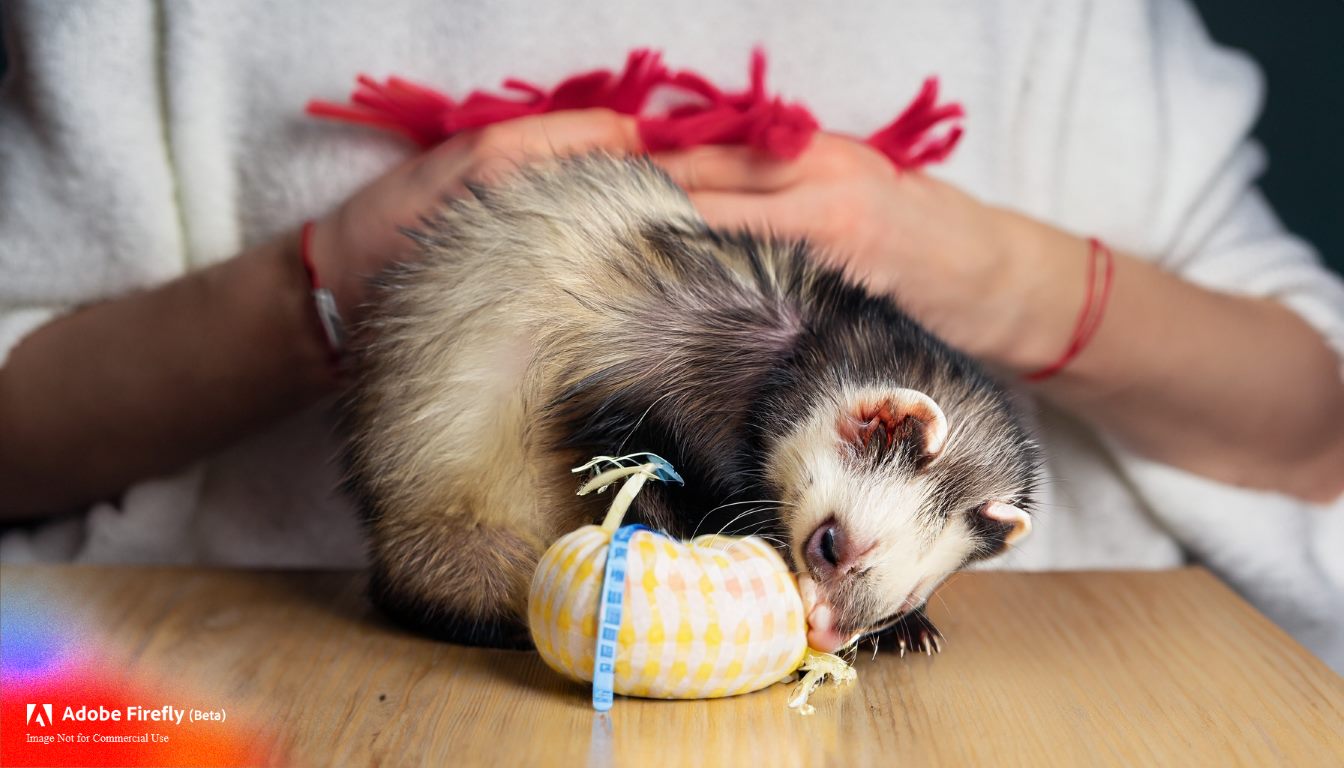
Here are some great ideas for inexpensive ways to keep your pet ferrets entertained and stimulated from
Homemade ferret toys are a great alternative to those you can buy at stores. These can help you to save a bit of money.
Toys are very important to keep your fuzzy stimulated when out playing. However, all ferrets are different and will find different things interesting (just like humans). Each ferret has its own individual personality and with that come their own individual likes and dislikes.
So if you have many ferrets, sometimes it can be hard to cater to all their needs. The more time you spend with them and bond, the more you will know about your ferrets and what they want to play with.
Ferrets are great because most of the time they will create their own homemade ferret toys. For example, they can take a liking to your clothing and tunnel through it or steal it.
Homemade ferret toys come in many shapes and forms but always remember to supervise your fuzzbutts during play. You don’t want them swallowing something that their not supposed to ( it can get stuck in their tiny intestines).
Read entire article here.
We ferret owners are all a little “crazy” about our fuzzy kids. Just as we do for our human children, we want the best, most-stimulating toys we can afford for our pet ferrets. But how do we wade through the thousands of choices and the many manufacturers? And where is the best place to get ferret toys? And what about homemade toys?
These are the questions this little book, Ferret Toys: Keeping Pet Ferrets Happy, will answer. You will find out:
* How to choose ferret toys wisely, both ferret-wise and money-wise
* How to choose toys that will engage your ferret’s senses and keep him active and interested
* How to know whether a toy is safe for your ferret
* The top ferret-toy manufacturers
* The best places to buy ferret toys
* How to create inexpensive and fun homemade ferret toys (with step-by-step directions)
* How to take care of your ferret’s toys so they will last longer and be safer
While you’re at it, be sure to check out Karen’s more comprehensive book on ferret care, ferret health, and ferret toys: Getting Started with Pet Ferrets.
A New Ferret Book that Includes Both Getting Started with Pet Ferrets and Ferret Toys – With Updated Information and New Material
Here’s a brief description:
So you finally got that pet ferret you’ve been wanting. But now what?
Ferrets do make great pets. They are fun, quirky, lovable, playful, mischievous, and entertaining little critters. But they also require a commitment on your part. You will need to invest time, money, and energy to take care of your woozles properly. Reading our 2 in 1 Ferret Book will aid you in preparing and getting outfitted for your ferret journey – especially the ferret-cage and ferret-readiness checklists.
And then there are the toys – most likely lots of them. Just as we do for our human children, we want the best, most-stimulating toys we can afford for our pet ferrets. But how do we wade through the thousands of choices and the many manufacturers? And where is the best place to get ferret toys? And what about homemade toys?
This book contains our two top-selling ferret books with new additional material.
Our new 2 in 1 Ferret Book will give you the basics of ferret care and the low-down on ferret toys. It’ll also save you some money – always a good thing this time of year.
Happy Holidays!
There is, of course, a dizzying multitude of ferret toys on the market. So trying to find great toys for your fuzzies can be both confusing and overwhelming.
And because of that, it’s easy to spend a small fortune trying to find just the right toys for your pet ferrets. But maybe this post will make it a little easier and save you time and money. Following are the toys my fuzzies have chosen as their top 3 favorites.
Ferret Tunnel System
This consists of a long section (or sections) of pliable, bendable clear-plastic tubing. It’s about 4 to 5 inches in diameter and has enough stiffness to retain its shape while your carpet sharks travel through it. They won’t get stuck because, with a little effort, they can turn around in the tunnel.
You can also purchase various attachments to go on the ends of the tunnel. These make the tunnel play even more fun for them and more enjoyable for you to watch. This tunnel system was my best (and fairly inexpensive) ferret-toy investment. My babies absolutely love scampering through, around, and over their tunnel toys.
Ferret Ball Pit
This is another simple and inexpensive toy that my ferrets love. It’s just a box filled with hard-plastic balls. They jump into the box, burrow in among the balls, and wrestle with one another while in the box. My babies love this toy almost as much as they do their tunnels.
Just make sure that if you do get a ball pit, the balls are large enough that your ferret(s) can’t swallow them. Also, the balls should be made of hard plastic – NOT rubber – so your fuzzy family members can’t bite or chew off pieces and ingest them.
Ferret Peanuts
Another simple and inexpensive toy, the peanuts, were, for a long time, my ferrets’ favorite. Again, this toy consists of just a box filled with ferret-fancy-tickling objects.
These objects look just packing peanuts – but they are NOT. Never let your ferret(s) play with Styrofoam objects of any kind. They can bite off small pieces of the Styrofoam and ingest them – which could result in a trip to the ET and maybe even surgery for your pet.
However, the peanuts in this toy are made of starch that is completely harmless to ferrets if ingested. And, boy, do my guys and gal love to dive into the box full of peanuts and get after it. They burrow, they wrestle, they swim, they leap out and back in, they –
Well, see for yourself in this video:
For more tips and ideas on commercial and homemade ferret toys, look at Ferret Toys: Keeping Pet Ferrets Happy.
Here’s a video I came across just today that deals with our book on ferret care: Getting Started with Pet Ferrets. I didn’t know this was out there, but thanks go out to Crafts Book Mix.
Here’s an excerpt from our soon-to-be-released little book titled A Ferret Manuel: How to Train and Manage Your Human. It’s a humorous ferret’s-eye view of the often comical relations between humans and pet ferrets.
So, you’ve finally acquired your very own human, have you? Good. Good for you and congratulations! It sure beats being crowded together with a bunch of total strangers in a tiny cage at the pet store, doesn’t it? But . . . while this is a great accomplishment and a first step toward a happy life in a home of your own, your job is just beginning. You have a lot of work and a long road ahead of you.
First of all, humans aren’t very teachable. But, then, there are very few animals as inquisitive and intelligent as ferrets. That means training your human will require, in varying degrees, as your unique situation demands, inventiveness, persistence, consistent application, and time.
Okay, let’s get started.
Introduction – An Overview of Human Nature
Following are the four important truths about or principles of human nature that will form the foundation of our guidelines and rules for training and managing your human. Remember these and adapt your training tactics accordingly, and you should see some success in your human-training efforts.
1. Humans are lazy creatures.
The thing you need to keep squarely in mind at all times is that adult humans are lazy. They don’t sleep nearly as much as we do, but they are far less active when awake. They seldom run, they don’t hide under the bed, and they never get on top of the dresser and play among the knickknacks. Even human kits (“children,” I think they call them) usually don’t play as vigorously as ferrets, and I’ve never seen one do the ferret “war dance.”
Because they are lazy, then, and slaves to the law of inertia, humans are just downright hard to train. The difficulty lies in getting them to change a behavior. For some bizarre reason, they prefer the familiar and easy to the better course. And never forget that humans just aren’t as smart as ferrets. There’s really nothing you can do about that, though.
For a human, it takes a lot of effort to learn something new and change a thinking pattern and/or a behavior. That’s why they dig in their heels and resist change: because it takes effort. Ironically, though, humans often expend more energy resisting change, owing to their inherent laziness, than they would actually making the change. (But, remember, they’re just not all that bright.) So, one of the keys to successfully training and managing your human will be persistence. You will simply have to work at it assiduously until you’ve achieved the desired results.
Just don’t give up. Success could be right around the corner.
2. Humans are incorrigible creatures of habit.
This truth about human nature is tightly bound up with the first one above. Because humans are lazy, they are also creatures of habit. They tend to keep doing the same thing the same way over and over because – well, because it’s just easier for them that way. It will take a lot of effort on your part to get your human to do something in a new and different way.
But the good news in all this is that once you’ve trained your human to engage in a certain behavior, your work is usually done with respect to that particular thing. Your human will keep doing whatever-it-is out of habit without thinking about it. While this aspect of human nature makes training your human quite a bit of work, it does mean that managing a behavior once inculcated is fairly easy.
Suppose, for example, you don’t like the food that your human has been giving you. You can’t, of course, just tell your human about it – she can’t speak our language. (Again, keep in mind that humans aren’t as clever as we are.) But after you’ve put in the necessary training effort (using some choice training tactics I’ll get to in a little bit), most of your work will be done. When your human learns to buy the kind of food you like best, she will keep doing it simply out of habit, even if she forgets the reason she started doing it in the first place. Once trained, humans are generally pretty easy to manage . . .
Pet ferrets have two favorite activities – sleeping and playing. But as much as our fuzzies like their sleep, play time is what really makes them light up. And that means toys. Lots of toys.
Keeping your ferrets supplied with plenty of new, stimulating toys can get pretty expensive. So here are a couple of ideas for homemade ferret toys that your woozles will likely enjoy.
Tennis-ball Toy
You will need:
1 tennis ball
Box cutter
Strong rope or cord (any length)
Directions:
1. Use the box cutter to cut a hole through the tennis ball.
2. Thread the rope or cord through the tennis ball.
3. Tie a knot at one end of the rope, large enough that the rope won’t slip out of the ball.
4. You now have a teaser toy to use with your ferret.
5. Inspect the ball and the rope regularly and replace as necessary.
Pillow Toy
You will need:
Scraps of fabric (at least 4 inches by 4 inches)
Scissors
Cotton batting
Jingle bells (optional)
Needle
Thread
Directions:
1. Lay a fabric scrap onto a flat surface.
2. Lay a second fabric scrap on top of it.
3. Cut the two layers so they match in shape (whatever shape you choose).
4. Sew together all but one side of the shape.
5. Turn the shape inside out.
6. Fill with cotton batting and jingle bells.
7. Sew the remaining side securely.
Your ferret now has a new toy. Inspect the pillow regularly to make sure the seams are secure. Repair and restuff as needed. The jingle bells should be no smaller than 2 inches in diameter to avoid a choking hazard.
Excerpted from Ferret Toys: Keeping Pet Ferrets Happy, where you can find many more tips and ideas for making fun, inexpensive homemade ferret toys.
Pet ferrets, of course, love their sleep time, but play time is what really makes them light up. And that means ferret toys – and lots of ‘em. But you need to make sure the toys you get
for your favorite fuzzies are truly ferret safe.
Below are a few guidelines for making sure your ferret’s toys are suitable and safe:
- Make sure the ferret toys you purchase are specifically designed for ferrets. Ferrets can chew through dog or cat toys in seconds, thanks to their sharp teeth and strong jaws. This means it’s possible for them chew off and ingest small bits of these toys and ingest – which can lead to choking and/or intestinal blockage.
- Ensure that the toys are free of small decorations that can be chewed off and swallowed. This includes ribbons, bows, jingle bells, buttons, etc. As a general rule, ferret toys and toy attachments should be at least two inches square to avoid the possibility of the toys or their parts being swallowed.
- Make sure all ferret tunnels and nesting holes are at least four inches in diameter so your ferret won’t get stuck.
- Likewise, make sure all ball toys are at least two inches in diameter so your ferret won’t choke on them.
- Avoid toys made of cardboard, rubber, foam, plastic, Styrofoam, and wood chips. Also avoid easily chewable fabric, including socks, hosiery, drawstrings, etc. Use only the starch packing peanuts – and NOT Styrofoam packing peanuts – if you want a ferret dig box.
- Carefully examine your ferret’s toys at least once a week. Replace any loose stuffing, and repair any torn seams. Discard any plastic toys that have cracked or have loose parts. Clean any toys that have become stained, and use plain water so your ferret won’t ingest anything toxic.
Also, if your pet ferret seems to have lost interest in a favorite toy that is still in good shape, clean it and then put it aside in a hidden place for a few weeks. When you bring it out again, your ferret is likely to see it as a brand new toy.
We’ve discussed essential ferret supplies and ferret accessories. Now, where can you find them? There are several options.
Pet store. The most obvious option is to go to your local pet store where you’ll likely find many brands and styles of ferret supplies. These items are all new so you won’t be inheriting someone else’s problem. Store employees can usually advise you on general pet care. The disadvantages are that pet-store items can be expensive, employees may not know much specifically about ferrets, and because ferrets are often considered to be “exotic” pets, the store may not stock many supplies.
Veterinarian’s office. Many vets have taken to selling pet supplies, especially vitamins, supplements, and other health-care items. If you have to visit the vet anyway, you can save yourself some time and gas by buying your ferret supplies at the same time. You’ll also have ready access to expert help: you can ask your vet about the item you are buying. But sometimes vets don’t actually know much about the item(s) in question. Some vets simply agree to stock the item in order to receive a portion of the proceeds.
Discount stores. Many general-merchandise stores have pet departments. Generally, this is fairly convenient. You can by ferret supplies while you buy your family’s weekly groceries. And discount-store prices are often much lower. Still, the store may not stock supplies specifically for ferrets. Further, the store staff also will not be likely to provide much ferret-related help.
Thrift stores. Many people have found pet cages, toys, and other supplies at their local charity thrift store. These stores are also great places to purchase old clothing for ferret bedding. Prices are low, and items are pre-owned so you won’t fret if something is lost or broken. Also, pre-owned clothing is usually much softer than new. Your ferrets will love the softness. However, you don’t know where the item has been or why the previous owner donated it. Thus, it is essential to thoroughly clean and sanitize each item before providing it to your ferret.
Classified ads. Newspapers, ferret publications, and online classified-advertising sites frequently list items for sale by other owners. As with thrift stores, you can often find good items at excellent prices. You can ask the owner about why they want to sell them and even “pick his or her brain” about various aspects of ferret care. You need to be aware, though, that an unscrupulous seller may choose to not give you the full story about the item.
Rescue organizations. If there is a ferret organization in your area, this may be your best resource. Many organizations accept donated items and refurbish them to offer to new owners for free or for a nominal donation. Ferret-rescue organizations generally offer many resources to owners. And any donation goes to help make the world a better place for ferrets. Ferret organizations vary in their operations, and not all organizations offer items for sale or donation.
See? With all these options available, you can easily find a way to get all the essential
supplies for your pet ferrets. Then, the only thing you’ll need to provide is love.
And be sure and check out our new ferret story titled
“Danny and Oliver: A Ferret-Rescue Tale.”
Here’s a quick announcement about our new ferret book, published as a Kindle e-book and titled Ferret Toys: Keeping Pet Ferrets Happy. Check it out – we think you’ll find some useful information in this book.
Ferret Toys possesses two main virtues. It’s not too long, and it contains some ideas and plans for homemade toys for pet ferrets. Here’s how the blurb goes:
We ferret owners are all a little “crazy” when it comes to our fuzzy kids. Just as we do for our human children, we want the best, most stimulating toys we can afford for our pet ferrets. But how do we wade through the thousands of choices and the many manufacturers. And where is the best place to get ferret toys? And what about homemade toys?
These are the questions this little book will answer. You will find out:
- How to choose ferret toys wisely, both ferret-wise and money-wise
- How to choose toys that will engage your ferret’s senses and keep him active and interested
- How to know whether a toy is safe for your ferret
- The top ferret-toy manufacturers
- The best places to buy ferret toys
- How to create inexpensive and fun homemade ferret toys (with step-by-step directions)
- How to take care of your ferret’s toys so they will last longer and be safer
Our aim is to simplify – and make less expensive – the daunting task of choosing and making the best toys for your pet ferrets . . . with Ferret Toys.
Pet ferrets absolutely must have daily play time, as well as something to play with. Pick up any ferret magazine or check out any ferret website, and you will likely see countless ferret toys for sale. You may also find directions for making your own ferret toys. Is there an advantage to commercially produced toys over homemade ferret toys or vice versa?
Commercially produced toys:
- Are designed specifically for ferrets to play with. They use materials that are safe for ferrets and made with ferret safety in mind.
- Are produced in bulk so they are generally less expensive than they would be if you made them at home using identical materials.
- Can be returned if they break (if you keep the receipt).
- Often come with instructions for games you can play with your ferret.
- Can be of better quality. A manufacturer does not want to deal with hassle of shoddy workmanship.
- Can lead you to resources for other ferret information if you order them from a catalog, website, or magazine.
- Will look exactly as they are pictured in the ad, on the box, in the catalog, or on the site.
- Can be enjoyed the day of purchase (if bought at a brick-and-mortar store).
On the other hand, commercial toys:
- Can be more expensive than homemade toys because a commercial manufacturer has to price the item to make a profit and also cover packaging and other costs of doing business. Also, if you purchased them online or via a catalog, you may have to pay significant shipping and handling fees.
- Can be a hassle to return for a refund or an exchange.
- May expose you to increased “junk” emails and surface mail if the company manages to get your contact information during the sale.
If you choose to buy a commercial product, look for a toy designed specifically for ferrets made by a company that has expertise in and knowledge of ferrets. If necessary, carefully read the specifications to be sure the toy will fit your ferret’s situation. Check out the company’s return policy and save your receipt.
Homemade toys:
- Can be virtually free if they are created from items you already have around the house.
- Can be fun to create.
- Encourage you to develop your own talents.
- Are unique. No other ferret will have exactly the same toys yours does.
- Can become a source of income if you develop a toy that others may wish to buy for their ferrets.
- Are a labor of love for your pet (or as a gift for a fellow ferret lover).
On the other hand, homemade toys:
- May be unsafe because the materials used may not be healthy or safe for ferrets.
- Take time, money, and skill to produce. Your ferret won’t be able to play with them until they are done.
- Can’t be returned to a store if the item just doesn’t work well for your ferret.
- May require the sacrifice of a favorite item (such as a T-shirt or blanket) for your fuzzy’s pleasure.
If you decide to make your own ferret toys, read and follow all instructions carefully. Use only materials safe for ferrets (e.g., no cedar chips, no Styrofoam peanuts, etc.). Make sure all openings are at least 4 inches in diameter and that all toys are at least 2 inches in diameter. Make sure all seams are thoroughly sealed and all rough or sharp edges removed. Don’t hesitate to discard or remake an item if it appears unsafe for your ferret.
It’s easy to see, then, that there is no one-size-fits-all answer about which kind of ferret toy is best. Most ferret households have a mixture of both commercially produced and homemade toys.






